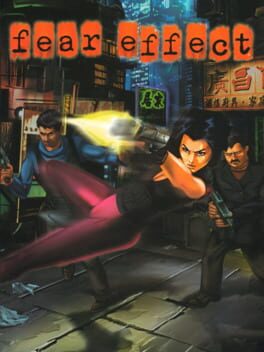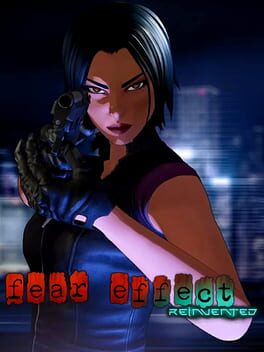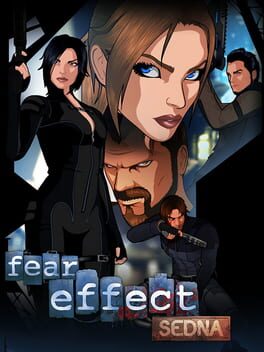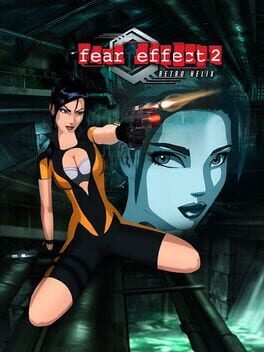

Fear Effect is an action adventure waiting to unfold! Wee Ming Lam disappears a few days before her 18th birthday under mysterious circumstances. Three ruthless mercenaries conspire to track her down and ransom her off to her father, Mr. Lam, a powerful Triad leader in Hong Kong. An extortion mission to retrieve Wee Ming Lam becomes a lesson in survival against the most unimaginable of enemies.
Also in series
Reviews View More
Terrible game design. Suddenly appearing bosses with one or two shots you. Terrible save points that definitely makes no sense and this is not we call "oldschool". For those wondering if this game is a survival horror, no it is not. It is an action adventure game with tank controls. I killed more man than playing Call of Duty.
I want to be clear that I’ve already lied to you by the time you’ve read this, because this game isn’t worthy of four stars. However, it is one of the most interesting and unusual games I’ve played in a long time, so I wanted to get the word out. If janky, mediocre PS1 games which fly off the rails are your thing, then go play it. Otherwise, I’ll just talk about its weirdness, spoiling things as I go.
So, the plot starts off in a Ghost-in-the-Shell cyber future, with your three protagonists entering the stage via the obligatory cyber helicopter. The first one you control is Hana, a slick super-spy who fits the mold of her time, essentially being Lara Croft by way of Motoko Kusanagi. Then, you have Glas, whose five o’ clock shadow and bright blue hoodie signify that he’s a hard-boiled detective undercover as a fifth grader. Finally, you have Deke, a potentially fake Australian who says “bloody” and “sheila” while wearing an unflattering turtleneck. The mission of this little mercenary band is to sneak into a yakuza hideout, and get information from their inside-man about the leader’s missing daughter. Sneak in, get the info, go out and find the girl, turn her in for a massive reward, easy. But of course, the job goes bad, the informant dies, the boss discovers what the mercs are up to, and they’re on the run. Now they have to get the girl as a bargaining chip for their own lives, and the race is on.
Please change the disc.
This game’s backgrounds are all pre-rendered videos, and it’s extremely central to this game’s identity. I may complain about how you have to juggle four discs to play a five hour game and laugh at the low resolution, but I can’t help but love how this game looks. I mean, it looks rough, but it’s the sheer commitment I respect. They didn’t want a rectangle with a circle on top as their helicopter; they created a fully-detailed model to be used in a pre-rendered video alongside other real-time effects. They wanted vents fogging up a rooftop with steam, not flat concrete walls. MGS-style head wiggling for talking wasn't good enough, they wanted animated faces with expressions and mouth flaps. They wanted an interactive animated feature within the limitations of the PlayStation, and that ambition really impresses me. I’ve played a ton of games which call back to this era, but they never replicate that ambitious attitude. They never capture the feeling of pushing the system to its breaking point, or of solving technical challenges with creativity. I mean, analog flaws are cool and all, but it feels like throwback games often miss the point by celebrating limitations for their own sake rather than for the creativity they engendered.
Please close the lid. Loading.
The second mission has you catching up to the missing girl, who’s in a town overrun by what seem to be zombies. She’s a little vague on the details, but she tells you that she “didn’t know that blood was the catalyst”. It’s a bit of a jump from the straight cyberpunk we started with, but sci-fi mixes with any genre pretty well, so it’s all good. She agrees to return to her father, as long as she gets to see a woman known as Madame Chen first, since she can explain things. But of course, Chen’s working with the yakuza, and the girl’s captured as soon as Glas brings her in the door. This third mission has you switching between characters in Madame Chen’s restaurant-slash-brothel: escaping capture as Glas, sneaking in as Hana, and kicking in the door as Deke.
This is an abrupt stop, but I’m about to drop a significant spoiler for the exact moment that shit flies off the rails. If this has piqued your interest at all, stop at the end of this sentence and go play it. This is the big reveal.
Ok, now change the disc again.
Glas and Deke are ambushed. They die, and their souls go to hell. The madame turns out to be a demon queen, and Hana kills her. Her blood melts a hole into the underworld. Hana descends the melted blood hell pit to go kill Satan.
That’s not an exaggeration. Not a joke. That’s what happens. You've spent the majority of the game as these two characters, and now they're bloody scraps. As hard of a tonal pivot as it is though, this is the exact moment where I totally fell in love with this clunky old game. With such an unsafe move, it achieved something that Resident Evil was never able to: the establishment of vulnerability when players are at their strongest. It’s a Predator-esque pivot where a lone action hero has to come to the realization they’re actually in a horror movie. You used to worry about normal soldiers shooting at you, and suddenly you’re facing demons with scythe hands. Maybe the zombies in the second chapter should have struck me more than they did, but I was expecting them to be explained away. I thought it would be revealed that the yakuza girl was genetically engineered to work with next-generation nanomachines or something, and that the nanobots in her blood were lethal to anyone else. I mean, the zombies in the games which inspired Fear Effect were the result of an engineered virus, and I don’t expect Jill Valentine to go kick Satan’s ass until RE10 at the earliest.
One last disc change.
That’s as far as I’ll spoil the plot, since I think it’s enough to convey why I have four-star love for this mediocre game. It’s just so wholeheartedly bold. Even to this day we get lazy rearrangements of Resident Evil and Silent Hill, but Fear Effect showed how to use the format while fearlessly establishing its own identity way back in 2000. It fought every technical limitation, ignored standard practices, and did its own thing. Being just as good as the other games out there wasn’t the goal at all, it had to blow people away. It probably shocked you at least once just in this summary, and I didn’t even include some of the cooler things it does towards the very end. So, I’m fine with it having a shit inventory system. I’m fine with a broken lock-on. I’m fine with all the flaws, because, as cheesy as it is to say, this game was never trying to be good, it was trying to be awesome.
So, the plot starts off in a Ghost-in-the-Shell cyber future, with your three protagonists entering the stage via the obligatory cyber helicopter. The first one you control is Hana, a slick super-spy who fits the mold of her time, essentially being Lara Croft by way of Motoko Kusanagi. Then, you have Glas, whose five o’ clock shadow and bright blue hoodie signify that he’s a hard-boiled detective undercover as a fifth grader. Finally, you have Deke, a potentially fake Australian who says “bloody” and “sheila” while wearing an unflattering turtleneck. The mission of this little mercenary band is to sneak into a yakuza hideout, and get information from their inside-man about the leader’s missing daughter. Sneak in, get the info, go out and find the girl, turn her in for a massive reward, easy. But of course, the job goes bad, the informant dies, the boss discovers what the mercs are up to, and they’re on the run. Now they have to get the girl as a bargaining chip for their own lives, and the race is on.
Please change the disc.
This game’s backgrounds are all pre-rendered videos, and it’s extremely central to this game’s identity. I may complain about how you have to juggle four discs to play a five hour game and laugh at the low resolution, but I can’t help but love how this game looks. I mean, it looks rough, but it’s the sheer commitment I respect. They didn’t want a rectangle with a circle on top as their helicopter; they created a fully-detailed model to be used in a pre-rendered video alongside other real-time effects. They wanted vents fogging up a rooftop with steam, not flat concrete walls. MGS-style head wiggling for talking wasn't good enough, they wanted animated faces with expressions and mouth flaps. They wanted an interactive animated feature within the limitations of the PlayStation, and that ambition really impresses me. I’ve played a ton of games which call back to this era, but they never replicate that ambitious attitude. They never capture the feeling of pushing the system to its breaking point, or of solving technical challenges with creativity. I mean, analog flaws are cool and all, but it feels like throwback games often miss the point by celebrating limitations for their own sake rather than for the creativity they engendered.
Please close the lid. Loading.
The second mission has you catching up to the missing girl, who’s in a town overrun by what seem to be zombies. She’s a little vague on the details, but she tells you that she “didn’t know that blood was the catalyst”. It’s a bit of a jump from the straight cyberpunk we started with, but sci-fi mixes with any genre pretty well, so it’s all good. She agrees to return to her father, as long as she gets to see a woman known as Madame Chen first, since she can explain things. But of course, Chen’s working with the yakuza, and the girl’s captured as soon as Glas brings her in the door. This third mission has you switching between characters in Madame Chen’s restaurant-slash-brothel: escaping capture as Glas, sneaking in as Hana, and kicking in the door as Deke.
This is an abrupt stop, but I’m about to drop a significant spoiler for the exact moment that shit flies off the rails. If this has piqued your interest at all, stop at the end of this sentence and go play it. This is the big reveal.
Ok, now change the disc again.
Glas and Deke are ambushed. They die, and their souls go to hell. The madame turns out to be a demon queen, and Hana kills her. Her blood melts a hole into the underworld. Hana descends the melted blood hell pit to go kill Satan.
That’s not an exaggeration. Not a joke. That’s what happens. You've spent the majority of the game as these two characters, and now they're bloody scraps. As hard of a tonal pivot as it is though, this is the exact moment where I totally fell in love with this clunky old game. With such an unsafe move, it achieved something that Resident Evil was never able to: the establishment of vulnerability when players are at their strongest. It’s a Predator-esque pivot where a lone action hero has to come to the realization they’re actually in a horror movie. You used to worry about normal soldiers shooting at you, and suddenly you’re facing demons with scythe hands. Maybe the zombies in the second chapter should have struck me more than they did, but I was expecting them to be explained away. I thought it would be revealed that the yakuza girl was genetically engineered to work with next-generation nanomachines or something, and that the nanobots in her blood were lethal to anyone else. I mean, the zombies in the games which inspired Fear Effect were the result of an engineered virus, and I don’t expect Jill Valentine to go kick Satan’s ass until RE10 at the earliest.
One last disc change.
That’s as far as I’ll spoil the plot, since I think it’s enough to convey why I have four-star love for this mediocre game. It’s just so wholeheartedly bold. Even to this day we get lazy rearrangements of Resident Evil and Silent Hill, but Fear Effect showed how to use the format while fearlessly establishing its own identity way back in 2000. It fought every technical limitation, ignored standard practices, and did its own thing. Being just as good as the other games out there wasn’t the goal at all, it had to blow people away. It probably shocked you at least once just in this summary, and I didn’t even include some of the cooler things it does towards the very end. So, I’m fine with it having a shit inventory system. I’m fine with a broken lock-on. I’m fine with all the flaws, because, as cheesy as it is to say, this game was never trying to be good, it was trying to be awesome.
Unlike the cinematic AAA releases of modern gaming today, Fear Effect doesn’t sacrifice what makes games fun to play in order to achieve an engrossing experience.
While recent AAA games often prioritize cinematic experiences at the expense of player agency, Fear Effect seamlessly blends cinematic elements with gameplay that demands active participation. Instead of mindlessly going through the motions with unenthusiastic side quests and simplistic action, you are constantly problem solving and thinking quickly on your feet. You don’t need to sacrifice effective gameplay to have a cinematic experience, and Fear Effect proves that.
The narrative is a winding and strange tale featuring morally gray characters and an eccentric plot that defies expectations set by disc 1. While relatively straightforward and easy to follow, it remains engaging due to how unique it is. The unexpected twists and turns, unparalleled plot devices, and impressive pacing will leave you eager to see what happens next.
This game is a technical marvel. Every single background is an FMV, similar to a sparse few scenes in Final Fantasy VII. They transition smoothly and the various surroundings are all breathing and full of life. But it’s not all looks, the FMV’s are a huge part of Fear Effect’s gameplay philosophy, as boss fights and puzzles use these often. Fear Effect is only 7 or so hours and it’s on 4 discs. It could be the shortest 4 disc game in the PS1’s library, but I’m not sure.
While Fear Effect is more simple in level design and lacks a consistent labyrinthine structure such as those found in survival horror contemporaries, it compensates in surprising ways. The intuitive combat, with its quick invincible dodge roll, stealth elements, remarkable enemy variety, and real-time ammo and weapon management is possibly the best combat found in a fixed camera-angle tank control release, only rivaled by the intense fast-paced arcade action of Dino Crisis 2. The wholly unique set-pieces that work congruently with pre-established gameplay mechanics offer ever-changing variety. Moreover, the puzzles in Fear Effect strike a perfect balance. They are challenging enough to engage players and make you rack your brain, yet avoid veering into cryptic territory. I was able to complete Fear Effect without referring to a guide. All these aspects contribute to the creation of fantastic level design. It is simpler than something like the original Resident Evil but still succeeds in keeping the player in a perpetual state of problem-solving and critical thinking.
Getting into Fear Effect can be a bit daunting, however. It’s a difficult game with swift deaths during combat and has a reliance on a trial and error design philosophy. Granted, there are sections in Fear Effect that exhibit poor design, showcasing trial and error at its most frustrating, The initial helicopter encounter and the train boss fight being prime offenders that come to mind. However, these instances, while occasionally perplexing, were seldom frustrating. They never dissuaded my pursuit of the next plot revelation, combat challenge, or mind-bending puzzle.
The trial and error design and swift deaths can be peculiar at times. Staring at the loading screen for 10 seconds isn’t fun, but the rest of this game sure is. It seamlessly blends enthralling storytelling and cinematic elements without sacrificing gameplay whatsoever. Fear Effect excels at survival horror puzzle solving and action. The level design is less complex than the contemporaries on the PS1, but it successfully blends it’s elements together to make an immersive experience that I’d recommend to survival horror fans, PS1 enthusiasts, and anyone that enjoys good video games.
9/10
While recent AAA games often prioritize cinematic experiences at the expense of player agency, Fear Effect seamlessly blends cinematic elements with gameplay that demands active participation. Instead of mindlessly going through the motions with unenthusiastic side quests and simplistic action, you are constantly problem solving and thinking quickly on your feet. You don’t need to sacrifice effective gameplay to have a cinematic experience, and Fear Effect proves that.
The narrative is a winding and strange tale featuring morally gray characters and an eccentric plot that defies expectations set by disc 1. While relatively straightforward and easy to follow, it remains engaging due to how unique it is. The unexpected twists and turns, unparalleled plot devices, and impressive pacing will leave you eager to see what happens next.
This game is a technical marvel. Every single background is an FMV, similar to a sparse few scenes in Final Fantasy VII. They transition smoothly and the various surroundings are all breathing and full of life. But it’s not all looks, the FMV’s are a huge part of Fear Effect’s gameplay philosophy, as boss fights and puzzles use these often. Fear Effect is only 7 or so hours and it’s on 4 discs. It could be the shortest 4 disc game in the PS1’s library, but I’m not sure.
While Fear Effect is more simple in level design and lacks a consistent labyrinthine structure such as those found in survival horror contemporaries, it compensates in surprising ways. The intuitive combat, with its quick invincible dodge roll, stealth elements, remarkable enemy variety, and real-time ammo and weapon management is possibly the best combat found in a fixed camera-angle tank control release, only rivaled by the intense fast-paced arcade action of Dino Crisis 2. The wholly unique set-pieces that work congruently with pre-established gameplay mechanics offer ever-changing variety. Moreover, the puzzles in Fear Effect strike a perfect balance. They are challenging enough to engage players and make you rack your brain, yet avoid veering into cryptic territory. I was able to complete Fear Effect without referring to a guide. All these aspects contribute to the creation of fantastic level design. It is simpler than something like the original Resident Evil but still succeeds in keeping the player in a perpetual state of problem-solving and critical thinking.
Getting into Fear Effect can be a bit daunting, however. It’s a difficult game with swift deaths during combat and has a reliance on a trial and error design philosophy. Granted, there are sections in Fear Effect that exhibit poor design, showcasing trial and error at its most frustrating, The initial helicopter encounter and the train boss fight being prime offenders that come to mind. However, these instances, while occasionally perplexing, were seldom frustrating. They never dissuaded my pursuit of the next plot revelation, combat challenge, or mind-bending puzzle.
The trial and error design and swift deaths can be peculiar at times. Staring at the loading screen for 10 seconds isn’t fun, but the rest of this game sure is. It seamlessly blends enthralling storytelling and cinematic elements without sacrificing gameplay whatsoever. Fear Effect excels at survival horror puzzle solving and action. The level design is less complex than the contemporaries on the PS1, but it successfully blends it’s elements together to make an immersive experience that I’d recommend to survival horror fans, PS1 enthusiasts, and anyone that enjoys good video games.
9/10



